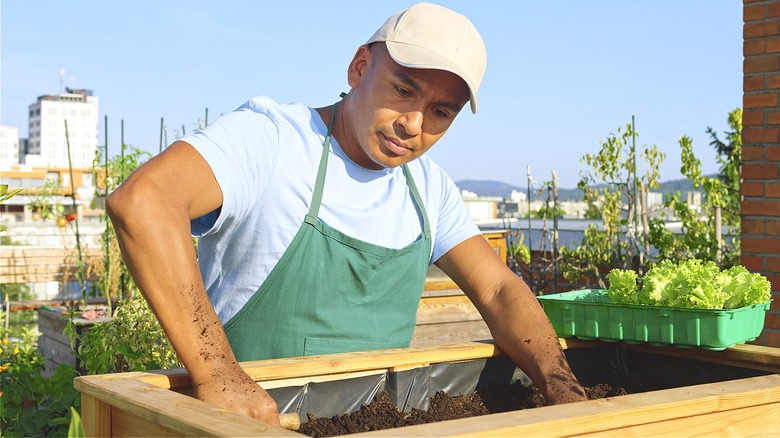The Step You Don't Want To Forget When Gardening In Planter Boxes
Planter boxes instantly transform any outdoor living space, regardless of how much room you have. Gardening in them adds pops of color to your patio or balcony and can even help attract beneficial insects like bees, especially if you plant geraniums. But planter boxes aren't limited to your patio or window ledge. You can build large planter boxes in your yard and use a variety of materials, including plastic, wood, metal, terracotta, concrete, stone, and ceramic. However, moisture can damage certain materials and, if you have wooden or metal planter boxes, you need to line them before beginning to garden.
If you forget and/or skip this gardening step, you run the risk of frequently replacing your planter boxes. As you water them, wood will slowly rot and metal will rust. But plastic liners can work to prevent how much moisture your planter boxes come into contact with. Yes, you need to replace your plastic liners eventually, but you may be able to get upward of 15 years' worth of use if you install a pond liner. This hack also keeps the ideal amount of moisture in your soil, depending on the material you use.
Choosing a planter box liner
The first step is selecting the type of material you want to line your planter boxes with. As said, wooden planter boxes aren't the only kind of planter you should use liners with; metal planters can also benefit from liners, although some come sealed already. However, steel planters, for example, can rust if they lack a protective coating. You should also use liners if your planter boxes are open on the bottom, as they work to keep burrowing pests and weeds out.
Plastic may be the best material to use as a liner, as it won't break down with time. Many gardeners use pond liners for their planter boxes, as they're sturdy and won't deteriorate, protecting a planter's construction thanks to the liner's thick nature. Some professionals recommend using porous landscape fabric. These liners let water drain from the soil. However, the issue with these liners is that the planters will still come in contact with water — albeit, less than if there were no liner at all.
After you select a liner material for your gardening planter box, line the inside of the planter, covering all exposed surface areas. Next, temporarily secure it in place with clamps. After that, permanently secure the liner using a staple gun or drill. You'll then have an outdoor wood or metal planter box ready for fruits, vegetables, flowers, and more.
